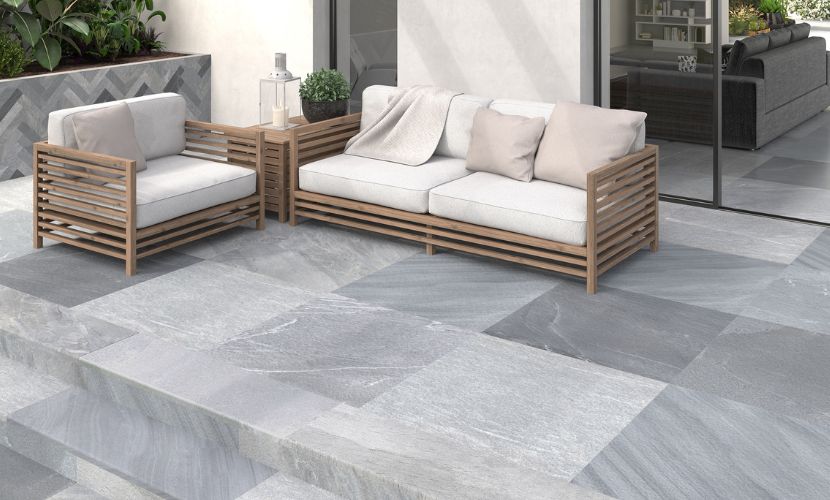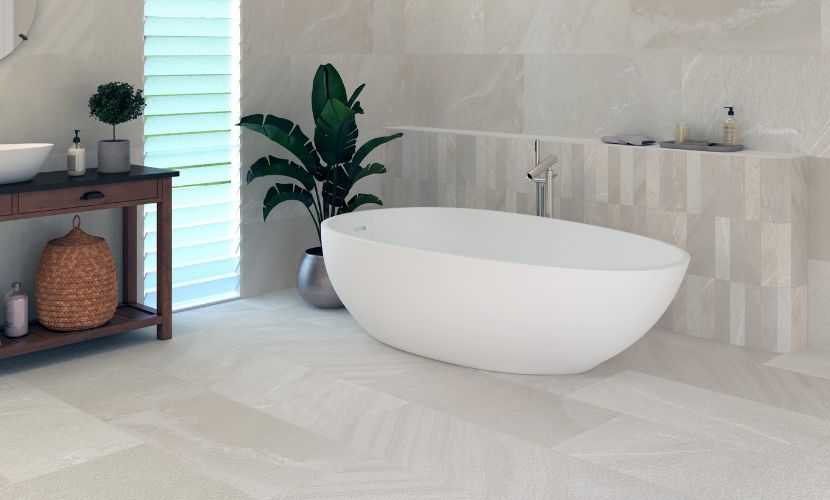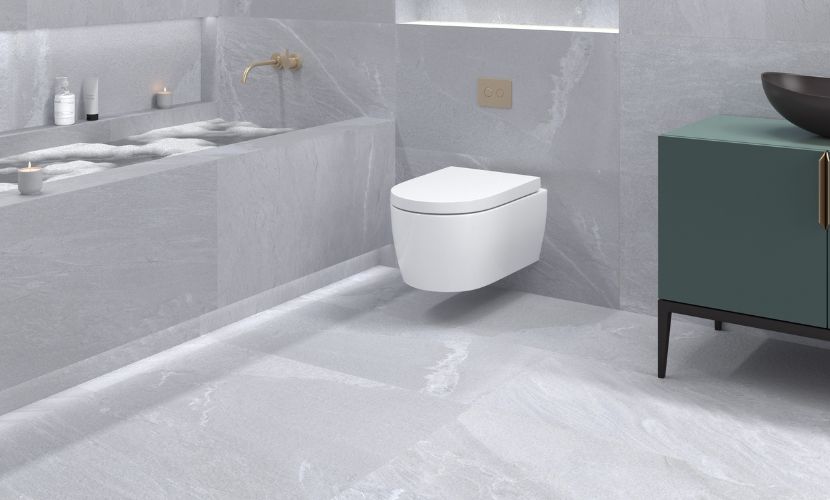Hard-wearing floors perfect for indoor and outdoor decoration
Flooring is a fundamental part of any interior or exterior decoration project. Whether we are talking about a kitchen, bathroom, terrace or garden, choosing the right flooring material is key to achieving a long-lasting and aesthetically appealing result. But what makes a floor really hard-wearing? I'm sure you have asked yourself this question more than once. From Dune, as experts in ceramic and vinyl flooring, we are going to analyse various aspects to give you answers to your questions. Let's get started!

In order for a floor to be resistant, it must be able to withstand the passage of time, the inclemency of the weather and daily use. In addition to this, aesthetics must not be neglected and, therefore, the most important thing is that a floor is able to withstand the admiring glances of all those who contemplate it. In this post we will explore some of the most popular and effective materials for creating resilient flooring, and discover how they can help us transform our spaces into temples of beauty and functionality.
Where is it most important to lay a resilient floor?
When it comes to choosing a resilient flooring for a home, it is important to bear in mind that not all rooms have the same needs. Some areas of the home are exposed to more wear and tear than others, whether due to constant foot traffic, the presence of pets, humidity, temperature or the accumulation of dirt. In this sense, we can say that there are three main rooms where it is, especially, important to lay a resistant floor:
- Kitchen:
The kitchen is one of the areas of the house that suffers most from the passage of time and constant use. Flooring in this space must be resistant to damp, stains, scratches and knocks. Materials such as porcelain stoneware, natural stone or polished concrete are excellent options for a resistant and durable kitchen.
- Bathroom:
The bathroom is another area that requires particularly hard-wearing floors, as they face constant moisture, water and chemical build-up. Ceramic, marble or granite are some of the materials best suited to the conditions in this space.
- Terraces and gardens:
In outdoor areas of the house, flooring must be able to withstand inclement weather, from rain and snow to exposure to sun and wind. Treated wood, cement, stone and ceramic tiles are some of the most resistant and aesthetic options for these spaces.

In addition to these three rooms, we cannot forget other areas of the home where the floor must also be resistant:
- Entrance halls:
The entrance is the "mirror of the soul" of the home and, therefore, the hallway is a place where it is essential to have a resistant floor. We must also bear in mind that it is the space that suffers the most from outdoor problems. Whether it's raining, you've got dirty or you've just arrived home, the hallway will always be the first place you step on when you get home, and that's why a hard-wearing floor is key.
- Basements and garages:
Due to the damp and enclosed conditions that these spaces suffer from, we must lay a resistant floor capable of withstanding the pressure. In addition, we must bear in mind that these are spaces designed to store cars and motorbikes, so we must use floors that resist oil stains, chemical products and the weight of vehicles.
- Passage areas:
Finally, it is important to bear in mind that any area of the house that has frequent traffic should have resilient flooring to prevent premature wear and tear and damage from bumps and scrapes. This includes hallways, entrances, stairs and communal areas such as the living or dining room.
What are the most resistant flooring materials?
Now that we have discussed the areas of the house that should have resilient flooring, we cannot overlook the most resistant materials that can be used for flooring in a home:
- Porcelain stoneware: a type of ceramic that is highly resistant to moisture, stains and wear and tear. It is a very versatile option, as it can imitate other materials such as wood or marble.
- Natural stone: marble, granite, slate and other types of stone are very resistant and durable, and can be an excellent choice for areas such as the kitchen or bathroom.
- Polished concrete: this is a very strong and durable option, ideal for high traffic areas or exteriors. It can also be customised with different colours and textures.
- Treated wood: wood can be a very warm and welcoming option for flooring, but it must be properly treated to resist moisture and insects. Oak, iroko or teak are usually very resistant options.
- Ceramic tiles: in addition to porcelain stoneware, ceramic tiles can be very resistant to stains and wear, and are a very versatile option from a decorative point of view.

More resistant porcelain floor models
Continuing with the task of designing resistant and, above all, beautiful floors, at Dune we have designed porcelain floors to create unique spaces. In addition to all the series of porcelain tiles we have, if there is one series that stands out for its resistance and versatility, it is Pietrasanta.

The new tiles stand out for their high technical performance, which allows them to be versatile in In&Out environments, while offering homogeneity in the design of the project. Undoubtedly, these tiles are trend-setting and are a basic element in the decoration of residential projects.
Are there differences between indoor and outdoor resilient flooring?
Yes, there are important differences between indoor and outdoor resilient flooring. In general, indoor flooring can afford certain aesthetic and comfort features that are not feasible outdoors, where the floor must withstand inclement weather and constant traffic.

Here are some of the main differences between indoor and outdoor resilient flooring:
- Moisture resistance: while indoors moisture is not usually a major problem, outdoors it is essential that floors are resistant to rain, snow and constant humidity. For this reason, materials such as porcelain stoneware or natural stone are often more suitable for outdoor use than wood or ceramic tiles.
- Resistance to wear and tear: outdoors, the floor must withstand constant traffic from people, animals and vehicles, which can cause significant wear and tear on the material. For this reason, it is important to choose particularly resistant materials such as polished concrete or ceramic tiles.
- Maintenance: inside the house, floors can be treated with milder cleaning and maintenance products, while outside, materials that are easy to clean and resistant to chemicals are necessary. In general, outdoor floors should be easier to maintain and clean than indoor floors.
- Aesthetics: finally, inside the house more decorative and aesthetic flooring options can be allowed, while outside it is important that the floor looks functional and hard-wearing. However, this does not mean that outdoor flooring cannot be attractive: there are many aesthetic and decorative options for outdoor flooring, such as the use of mosaics, decorative stones or gravel.

When to use high traffic tiles indoors and outdoors?
High-traffic tiles are an excellent choice for both the interior and exterior of the home. Here are a few reasons why you should consider using high traffic tiles in your construction or renovation projects:
- Durability: high traffic tiles are designed to withstand constant wear and tear and heavy traffic, making them much more durable than other flooring materials. This makes them ideal for areas of the home that see heavy use, such as the kitchen, dining room or backyard.
- Moisture resistance: many high traffic tiles are designed to be moisture resistant, making them ideal for use in areas such as the bathroom, kitchen or swimming pool. These tiles will not warp or crack with exposure to moisture, making them ideal for areas where water is a constant problem.
- Easy maintenance: high traffic tiles are very easy to maintain and clean. Simply wipe them down with a damp mop to keep them in good condition. They are also resistant to stains and chemicals, so they can be easily cleaned without risk of damage.
- Aesthetic versatility: high traffic tiles are available in a wide variety of styles, colours and designs, making them aesthetically versatile. They can be used in a wide range of projects, from the most elegant interior design to the most rustic exterior landscaping.
- Safety: high traffic tiles are generally more slip resistant than other flooring materials, making them safer for use in areas where there is a risk of falling, such as the swimming pool or outside the house on rainy days.
Heat-resistant kitchen tiles
In addition, if you are looking for tiles for your kitchen that are especially heat-resistant, there are some additional factors to consider. Here are some features to look for in heat-resistant kitchen tiles:
- Material: For tiles to be heat resistant, it is important that they are made of materials that can withstand high temperatures without damage. Some of the most heat-resistant materials are porcelain stoneware, ceramic and glass.
- Thickness: The thickness of the tiles is also important for their heat resistance. Thicker tiles tend to be more heat resistant than thinner tiles, as they are better able to absorb temperature changes and prevent cracking or breaking.
- Finish: The finish of tiles can also be important for their heat resistance. Tiles with a matt finish tend to be more heat resistant than glossy tiles, as they do not reflect light and do not heat up as much.
When to use high traffic tiles indoors and outdoors?
When using high traffic tiles indoors and outdoors, consider using them in areas where heavy use and constant exposure to adverse conditions is expected. Here are some examples of when it is appropriate to use high traffic tiles both indoors and outdoors:
- Commercial areas:
Commercial spaces such as shops, malls, restaurants and airports often experience a high volume of foot traffic. High traffic tiles are ideal for these environments as they are designed to withstand the wear and tear caused by large numbers of people walking on them.

- Entrances and lobbies:
These areas are entry and exit points to buildings and are often exposed to the elements. High-traffic tiles are resistant to moisture, wear and stains, making them a durable choice for entrances and lobbies.
- Kitchens and service areas:
Whether in homes, restaurants or commercial facilities, kitchens and service areas are subject to constant use and challenging conditions, such as liquid and chemical spills. High traffic tiles are able to withstand these situations without deteriorating easily.
- Swimming pools and outdoor areas:
High traffic tiles are resistant to moisture and temperature changes, making them ideal for outdoor areas such as patios, decks and swimming pools. They can withstand exposure to sun, rain and other weather elements without losing their strength and appearance.

It is important to keep in mind that although high traffic tiles are more resistant, they also require proper maintenance to ensure their durability. In addition, it is advisable to consult with a tile expert to obtain specific recommendations according to the needs of your project. Therefore, at Dune, we will be happy to help you and offer you the best solution. Shall we talk?


















